
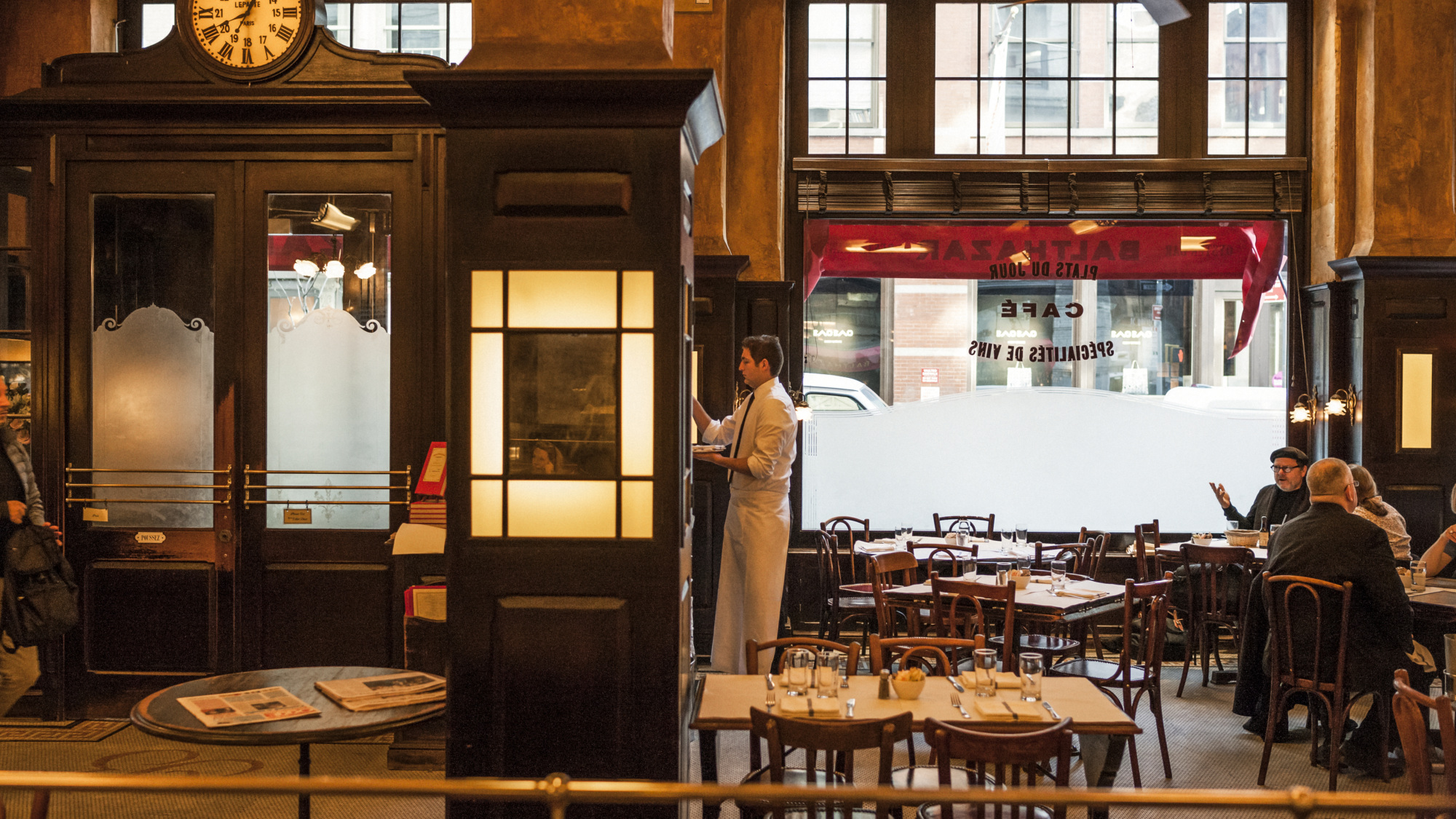
The Magic of Balthazar Has Always Been In the Details
Balthazar opened in the spring of 1997 and, in fact, there exists in my mind no recollection of a New York City before it. So full was its arrival on Spring Street, so profoundly did it change our collective understanding of what was possible for a neighborhood restaurant, so unequivocally did it render its stateside brasserie forebearers obsolete that I have to strain to think about how we did things before it. (Did we? We must have.) There is no question that it is the best and most convincing explanation for why New York City is synonymous with restaurants, and why New Yorkers believe so deeply that their restaurants are, just, better.
Indeed, as the great Soho brasserie turns 25 this month, there will be lots written about it. Its history and contribution to the development of Soho; Keith McNally, its visionary creator and keeper; and that it is a better Parisian restaurant than you can find in Paris. These are all valid and crucial storylines, consistent with the mountain of press that it has amassed over the years. (I have enthusiastically written little bits, too.) But, I would submit that, though the totality of the story can be wonderfully compelling, not nearly enough ink has been devoted to the restaurant’s hidden details, and the things that go on behind the scenes semi-secretly. In these details one can start to appreciate why this place stands above all of the others and how it has thrived for such an impossibly long time.
In putting together this essay of sorts, I asked a few individuals who were there then — 25-year veterans, iconic maitre d’s, the designer, and the food critic who awarded its first, glowing two-star review — to help me articulate the restaurant’s unique place in the world. I asked them in particular to sweat the small stuff.
~

Ian McPheely, Balthazar’s Co-Designer:
People walk in there and I think they’re blown away, right away, but don’t know why. Detail is a lot to do with it — it’s all handmade. It’s all dimensional materials. There are no veneers. All of the millwork, for example, is dimensional and, in this case, mahogany. And, what happens, then, is that the place just looks better after time.
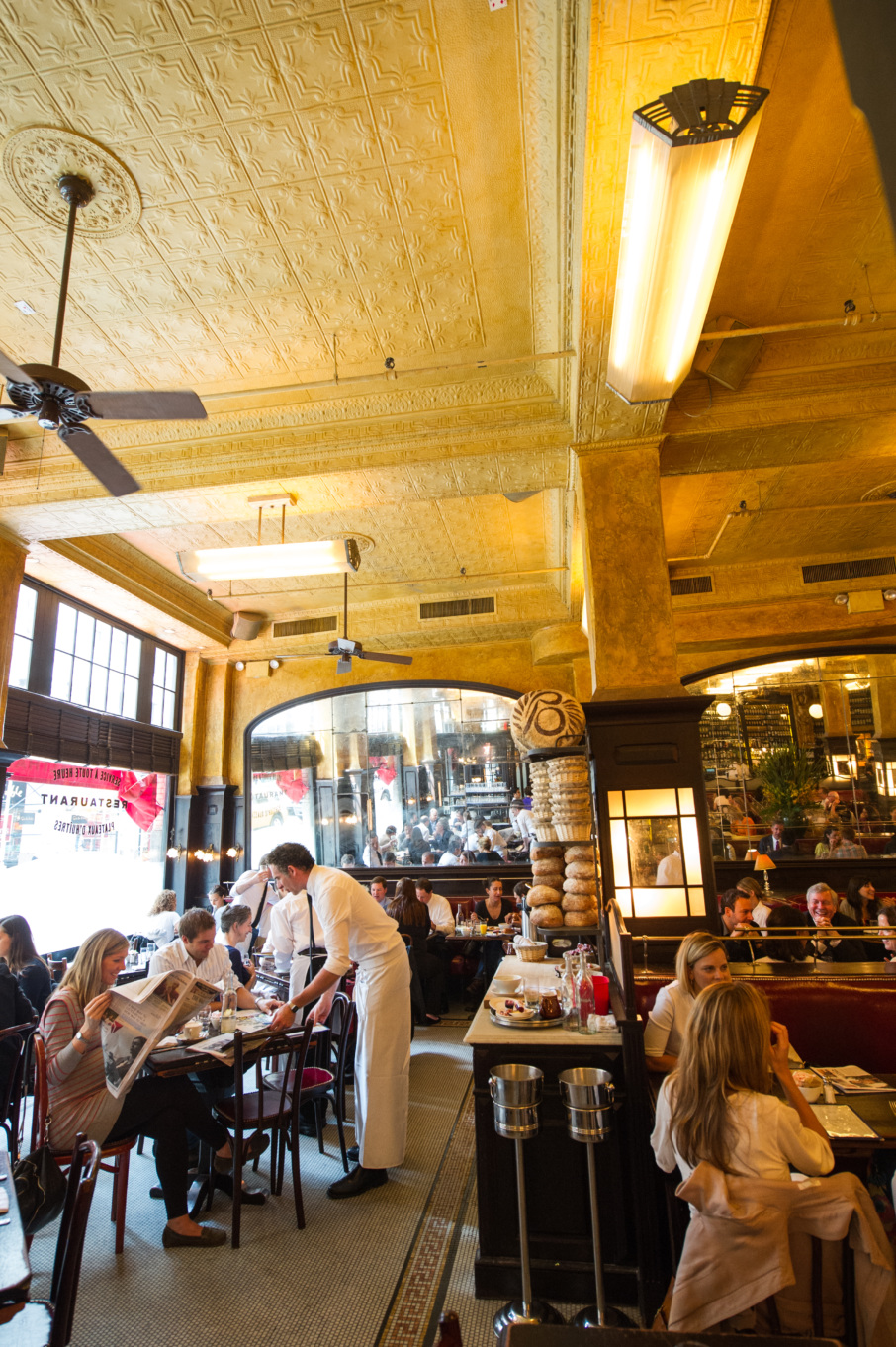
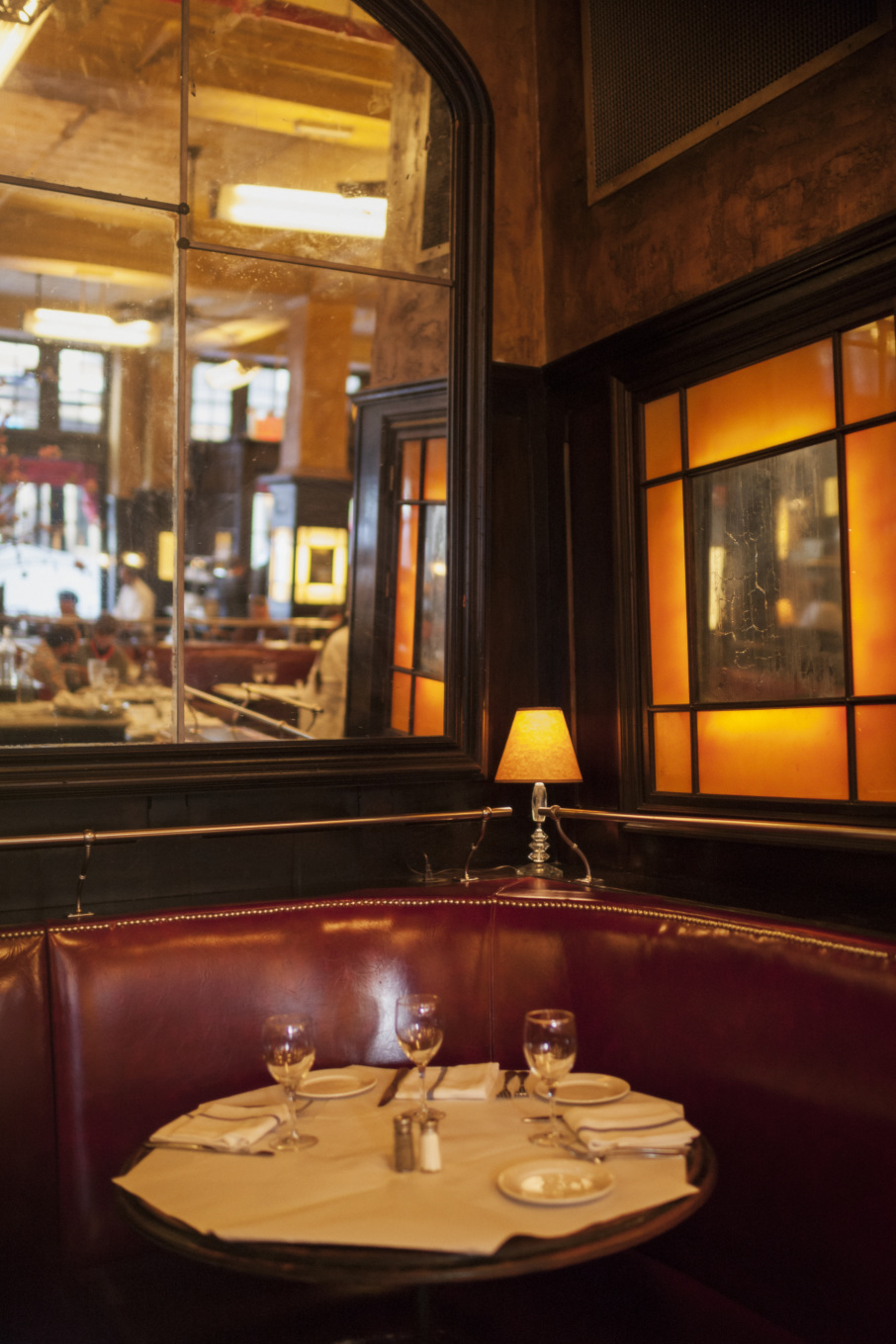
Zouheir Louhaichy, 25-year Veteran and Maitre D’:
There is something about Balthazar that is unequaled. That specific atmosphere is unique to Balthazar. That room. The minute you walk in, you are transported. You are no longer in Soho, you are no longer in New York. People come in and you can see it in their eyes. They say, “Oh, my God!” It’s just exciting. No single night is similar to any other night.
Pablo Basi, 25-year Veteran and General Manager:
The details are incredible. The calendar, for example, it comes from France. By September, I have to start calling and get it ordered. It’s not easy to find. It is a very specific format. The date, the days left in the year, the coordinates of the sun — it is a very particular thing. We don’t rip the days off, because, you know, let’s say to come to the bar on your birthday. You can request the calendar page. You write your name on a postcard, with your address, telephone and $5 cash. We put the postcard behind the page, which signals to the bartender that it has been requested. And, then, if no one else requests it, we put it in a tube and send it to you. If two people request the same day, we’ll get a copy made and send both out. We don’t take requests in advance.
One detail I have always loved, and always look forward to, is The Changing of the Paper. It happens something like this: You’ve just had your main dishes cleared and your table is dirty. A dining room staffer approaches and starts moving all of the glassware in what initially seems like a haphazard way. Half of the table is now bare except for the paper that covers it. Out from under his or her arm comes fresh sheets of table paper. They are crisp, layered, and folded. Down they go, and in the same motion the dirty sheets from the first half of the meal are whisked away and gone and glasses go back safely to where they started. Paper change complete. Your table is magically clean again. It is the single one of Balthazar’s many moves that I have never seen replicated elsewhere.
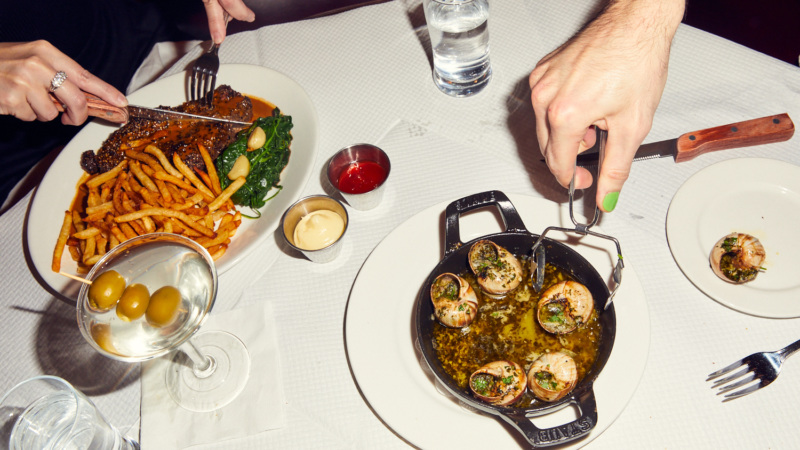
The One Who Keeps the Book New York
How to Get Into Balthazar — And Why It’s Still Packed 25 Years Later
Not many restaurants make it to 25 years, and even fewer are as perpetually packed as Balthazar has been from…
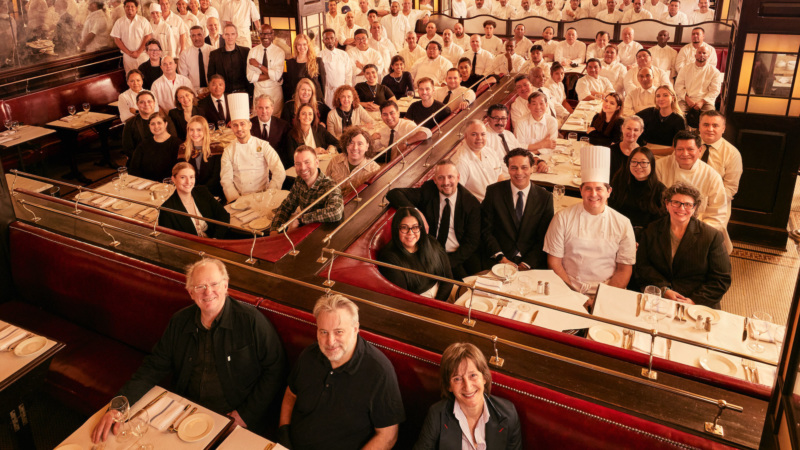
Balthazar Is Turning 25. Keith McNally Has … Thoughts.
Balthazar reaches the quarter-century mark this week, and having created one of New York’s most iconic restaurants, Keith McNally has…
Erin Wendt, 25-year Veteran and Director of Operations:
There are just some things you just can’t find anywhere else. That paper. It’s hard to find the paper. We will never share the source of it. A lot of places have the butcher paper and I think that’s fine. But … yeah. The paper. It’s a lovely touch. The bigger the table, the harder it is. The rounds are more difficult. You have to get the fold just right.
Kevin King, Former Maitre D’:
If I could tell you the number of people who have called me to ask where he gets that paper from. I don’t know who actually knows.
Other details abound. There was the phone in the vestibule that rang directly to the reservations office, should you want to book your next visit on your way out. (It has been temporarily removed, because the vestibule now also serves as a service corridor for all of the restaurant’s COVID-times outdoor seating.) The tiles, the wall color that perfectly matches the ceiling color, the clock above the door, the bevel of the tables, the hand-painted gold leaf lettering in the windows, the ‘B’ in the floor (an Instagram moment before there was Instagram), the matching ceilings in the bakery and the downstairs lounge areas.
Ian McPheely:
I had been to Paris before, but I slept in the train station. I had never been to a brasserie before. When we built Balthazar, there were a group of us that were mostly artists, musicians, filmmakers, and we built Balthazar in the basement. We did it all by hand, on sight, in the basement. I can’t give enough credit to the artisans and craftsmen who actually built this place by hand. I did everything on notebook paper and sketched it out. Nowadays you design and build everything ahead of time and build it, but we built this one on the fly. I would come in in the morning and show my sketches to the team, and we’d just go at it.
Erin Wendt:
The bread baskets that we have. In the beginning, you couldn’t find those breadbaskets. We had to special-order them. The napkins. The lighting. Everyone in this room is gorgeous in this lighting. The tile, the sound, the level of the blinds. Those things are measured. Nothing is by accident. Everything is designed.
There is even a 15-page manual dedicated just to how the host stand should be run.
Kevin King:
Keith looks at everything from a very humble way. You’re going to take care of the VIPs, of course. But Keith also wants to make sure the person in the back of the line is treated just as well. If you treat everyone how you want to be treated, you can’t screw things up. If I was here showing you the 15-page host packet — a good portion of it is about greeting a guest. You don’t stop talking to a guest until you’ve exhausted every option you have for that person. If you give everyone the right bits of information, no one is going to leave. If someone walks in at 6:45 and you say, “I have four 7 o’clock tables coming that haven’t shown up yet,” they’ll happily wait at the bar. There is a 10-minute rule for someone who comes in with a reservation. Every 10 minutes past your reservation that we are running late, I am going to talk to you. People need to know that they have not been forgotten.
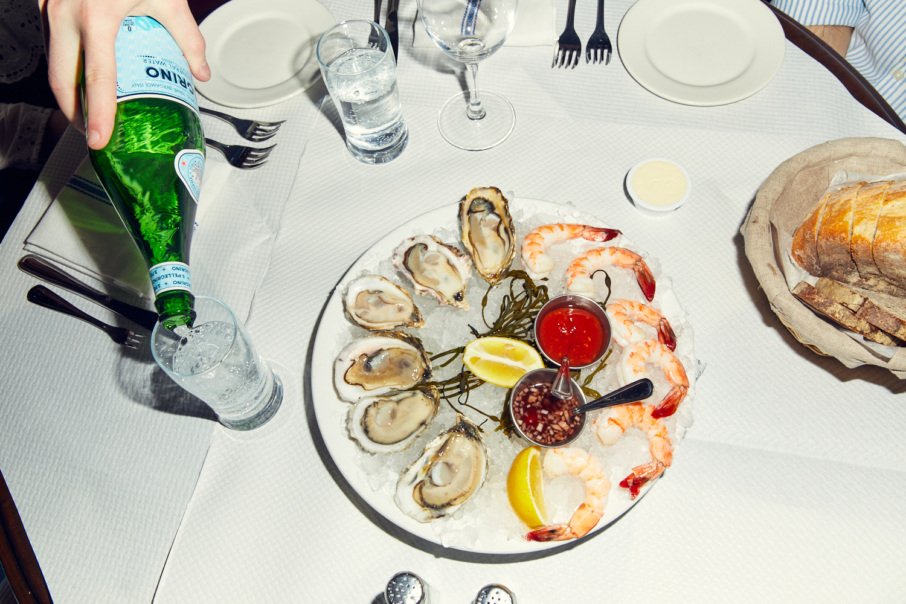

Photos by Meredith Jenks for Resy
Ruth Reichl, noted writer and former New York Times food critic:
When Alice Waters would come to town and I’d say, “Where do you want to eat?” She always wanted to eat at Balthazar.
So did I. Balthazar, it turns out, opened almost exactly as my adult life in New York City began. My first memory of the Balth is actually not of the restaurant at all, but of how nervous I was the first time I called 212-965-1414 for a reservation. Three rings, “thank you for calling Balthazar …” said the recorded lady with a French accent. Press two, hold, hmm, let me see. We can do 5:30 or 11. (Fortunately on that day I was also amenable to a lunch reservation; what better a place to decamp from my high school graduation ceremony?)
Eventually I would get in at a reasonable hour. And much, much later, after by some miracle McNally let me take over the restaurant for my wedding, my access got a little better. But, it turns out that access or not, it’s hard to find a bad table. Tables 10 and 24, two of the corners up front, are GM Pablo Basi’s favorites. He also loves the 90s, the bar booths. Kevin King likes 51 the best, a deuce tucked in the back corner; I have only ever seen McNally at 10 or 62. Erin Wendt likes the bar itself or the 80s, which are the cafe area tables. 61 and 90 are my two favorites, for what it’s worth.
It also must be said that it is just as pointless to try ranking dishes or even meal periods. For some, it is all about breakfast. For others, lunch or dinner prevail. Basi loves the foie gras terrine; King will invariably start with a seafood tower; Wendt is about short ribs on Saturdays.
But, perhaps the most impressive detail of all at Balthazar is the bar, which is in fact many details all put together. The story of the bar is the story of the restaurant itself. It is part New Yorker, part Parisian, and part entirely bespoke.
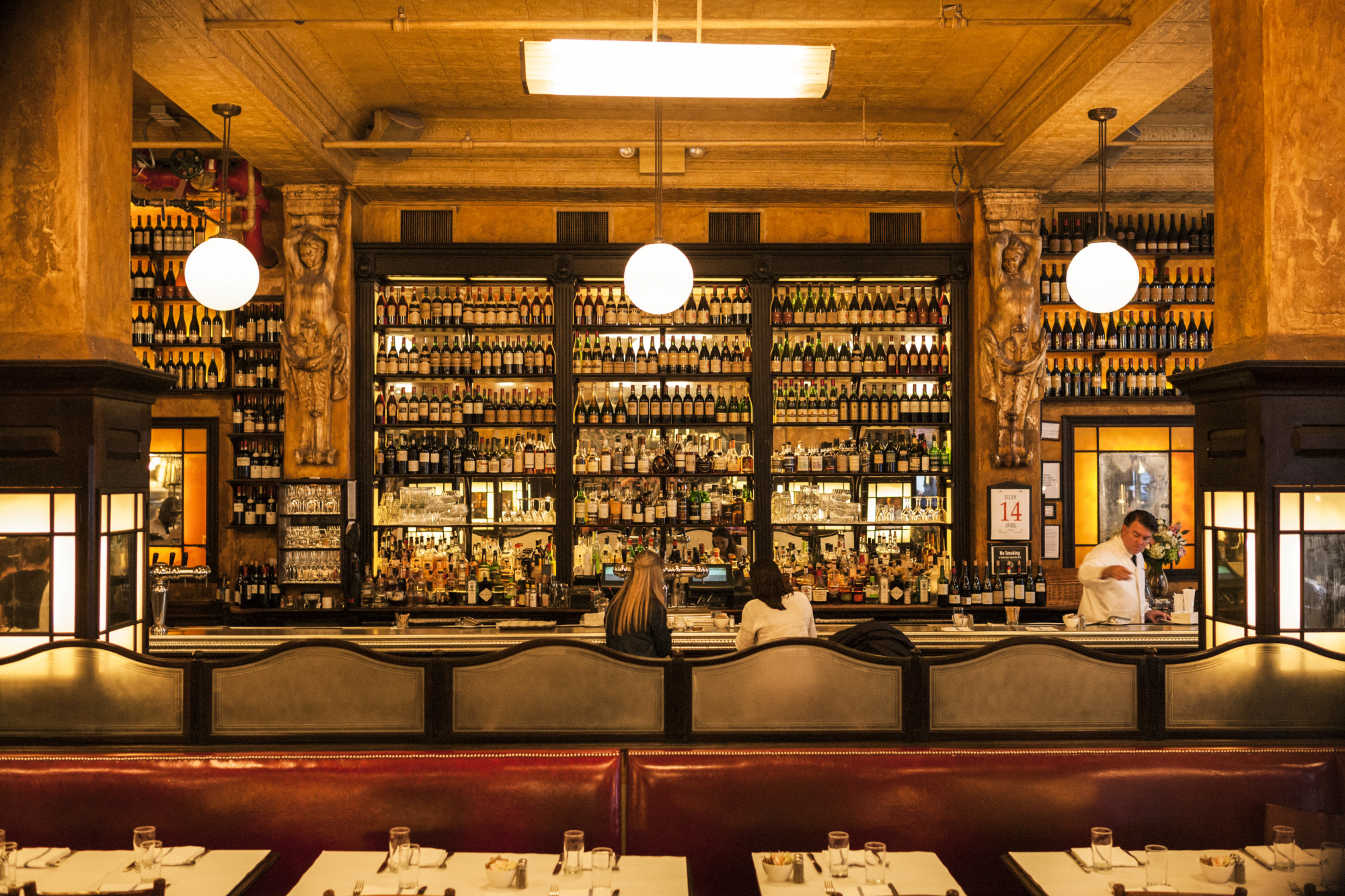
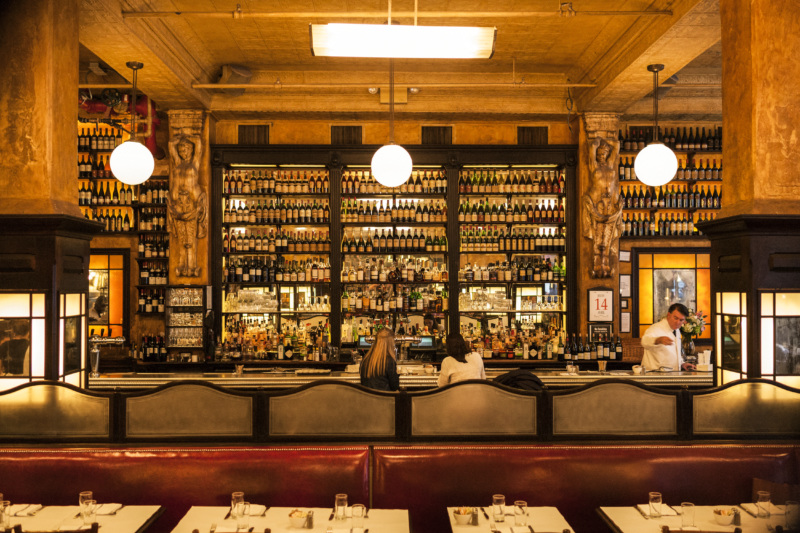
Ian McPheely:
Keith had this photo of a bar from the 19th century, I think, from the American West. He kept showing it to me. He carried it around in his back pocket and every day he would open it up and would say, “This is it.” It’s like a really grainy photo and it had cowboys leaning on the bar and just a massive wall of shelves with bottles on them. If you look at Balthazar today, that’s pretty much what it is.
Keith McNally (from the Balthazar Cookbook):
“It was a black and white photograph of an old, anonymous Parisian bar. I didn’t have a clue how to build the restaurant’s interior: its kitchen, oyster bar, booths, banquettes, bathrooms, entranceway, wine room and so on. But I felt that if I could build a bar with the look and spirit of the one in the photograph, then somehow everything else would fall into place.”
I asked McPheely and McNally both about the discrepancy between their stories.
Keith McNally:
I had come up with the notion for Balthazar years earlier while living in Paris. Like many good ideas this one came about accidentally. I was searching for vintage curtains in Clignancourt’s flea market when I came across a photograph of a turn of the century bar. Behind the bar’s zinc counter was an army of liquor bottles stacked twenty feet high. Flanking the bottles on either side were two towering statues of semi-naked women carved in a classical Greek style. I was so mesmerized by this magnificent bar that I forgot about the vintage curtains and bought the sepia-tinged photo instead. Over the next five years I carried the photo in my back pocket, thinking that if I ever found a space with a sky-high ceiling, I’d build a bar just like this. Stepping into the Adar Tannery, I knew that I’d found that space.
[Note: McNally sent me this answer, but it is also from a previous Vanity Fair article]
Ian McPheely:
No … it was the Wild Wild West.
Keith McNally:
The mahogany paneling came from Harlem. The pewter counter was cast in France. The caryatids were made in Brooklyn.
Ian McPheely:
He bought some decrepit bar in Harlem and it was just bits and pieces. That was the starting point. We kind of replicated those things. There are pilasters on the bar and there were carvings on it. It was pretty ornate. We had a carver on our team and he would carve the vignettes.
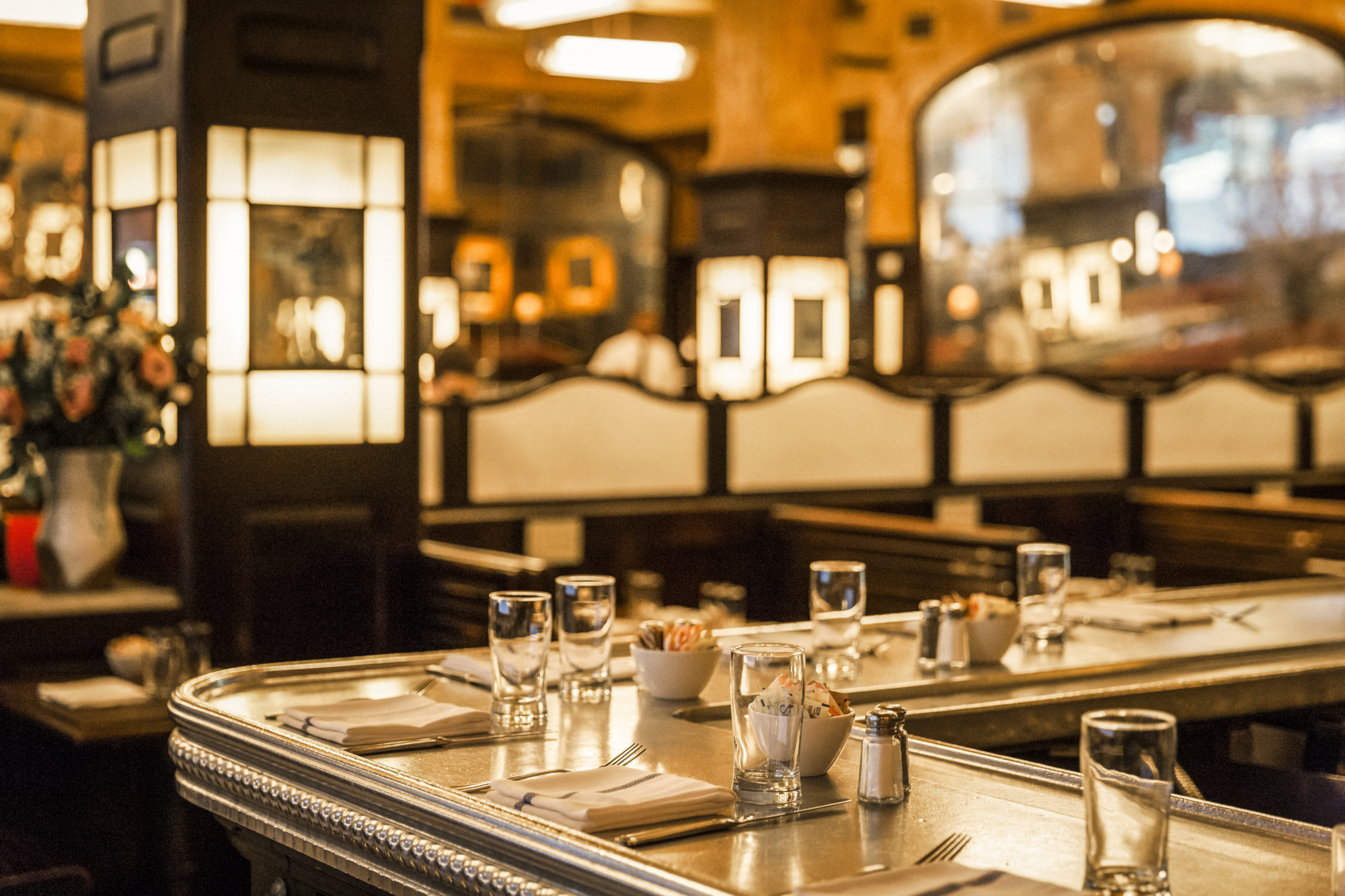
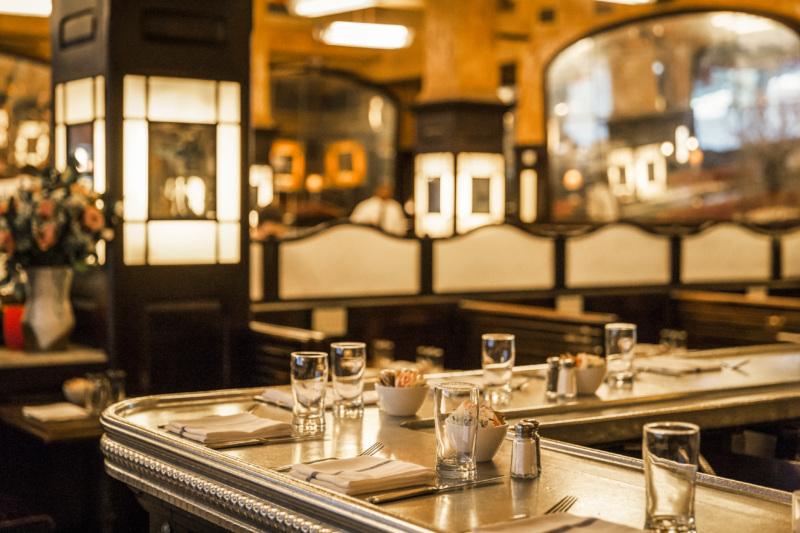
Pablo Basi:
For me, Balthazar is about how you can stand at the bar and see the entire room — that’s not an accident. You’re standing at the bar and you just want to be in the room. You can see everything. The six columns, the mirrors and the booths.
McNally [excerpted from Vanity Fair]:
“Ian McPheely and I stared at my photo of the colossal Parisian bar, wondering where the bar should go—assuming, that is, we could build it. It took us two weeks to work out its location, but once we did, the rest of the floor plan fell quickly into place.”
Ruth Reichl:
Balthazar defined a different kind of celebrity for restaurants. I started out my first review by saying, “Everybody wanted a seat.” It was, and is, just stunningly beautiful. [McNally] did such an incredible job of taking that turn-of-the-century look and bringing it to New York.
Ian McPheely:
It wasn’t Balthazar when we started it. I think it took us a year and a half to build. Originally it was just going to be a bakery and the food was going to be more modest. But, it just evolved.
As I write these words, a craving for Balthazar builds. A seafood tower to start; then, the Balthazar salad, a roast chicken, side of fries with au poivre sauce and a caramelized banana and ricotta tart. The story of McNally’s great Soho brasserie will continue to evolve, one detail at a time. Balthazar, now and forever, I say.
Ben Leventhal is the co-founder and former CEO of Resy, as well as the co-founder of Eater.
Discover More

Stephen Satterfield's Corner Table














